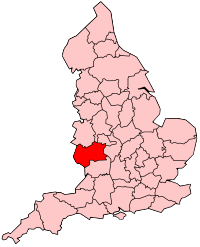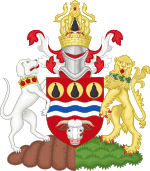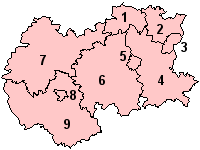Hereford and Worcester facts for kids
| Hereford and Worcester | |
 |
|
| Geography | |
| Status | Non-metropolitan county |
| HQ | Worcester |
| ONS code | 25 |
| History | |
| Created | 1974 |
| Abolished | 1998 |
| Succeeded by | Herefordshire (unitary) Worcestershire (shire county) |
Quick facts for kids Politics |
|
|---|---|
| Governance | Hereford and Worcester County Council |
 Coat of arms of Hereford and Worcester County Council |
|
| Subdivisions | |
| Type | Non-metropolitan districts |
Hereford and Worcester was a county in England that existed for 24 years, from 1974 to 1998. It was formed on April 1, 1974, by a law called the Local Government Act 1972. This law aimed to make local government more efficient. The new county combined most of the old Herefordshire and Worcestershire counties. It also included the big town of Worcester.
Some parts of Worcestershire, like Halesowen and Stourbridge, became part of the West Midlands county instead. This meant Hereford and Worcester was mostly a rural area, with lots of countryside.
The county shared borders with Shropshire, Staffordshire, and the West Midlands to the north. To the east, it bordered Warwickshire, and to the south, Gloucestershire. On its western side, it touched Gwent and Powys in Wales. In 1998, Hereford and Worcester was split back into two separate counties: Herefordshire and Worcestershire.
Contents
How Hereford and Worcester Was Created
The idea to combine Herefordshire and Worcestershire wasn't new. It was first suggested in 1948 by a group called the Local Government Boundary Commission. Later, in 1969, another report also proposed merging Herefordshire with parts of Worcestershire.
When the government introduced the Local Government Bill in 1971, the new county was first called "Malvernshire." This name came from the Malvern Hills, which are beautiful hills located roughly in the middle of the new county. However, many people made fun of this name, so it was changed. Another suggested name was "Wyvern," which combined the names of two rivers: the River Wye (which flows through Hereford) and the River Severn (which flows through Worcester). A wyvern is also a mythical dragon-like creature often seen in old symbols.
Many people in Herefordshire were not happy about the merger. Herefordshire was much smaller than Worcestershire in terms of population. They felt like it was a "takeover" rather than a fair merger. The main offices for the new county were also planned for Worcester, which is in the eastern part of the area.
A campaign called "Hands off Herefordshire" was started. On April 6, 1972, a Hereford bull was even led down a famous street in London, Whitehall, as part of a protest! People also signed a petition with 60,000 names, asking to keep Herefordshire as a separate county.
Even though many people in Herefordshire were against the merger, their local Members of Parliament (MPs) supported it. However, an MP from outside the county, Terry Davis, spoke out against it in Parliament, mentioning the large petition.
Originally, there was a plan for one big district in Herefordshire within the new county. But this changed, and Herefordshire was divided into smaller districts like Hereford, South Herefordshire, and Leominster. Part of Herefordshire also became part of the Malvern Hills district.
At the same time, large urban areas of Worcestershire, like parts of the Black Country and Birmingham suburbs, were moved to the West Midlands county. This helped create a more unified metropolitan area. As a result, Hereford and Worcester became a very rural county, known for its farms and countryside.
Districts of Hereford and Worcester
Hereford and Worcester was divided into nine smaller areas called districts. Each district had its own local council to manage things like local services and planning.
| Map | No | District | Composition |
|---|---|---|---|
 |
1 | Wyre Forest | Worcestershire: Bewdley, Kidderminster, Stourport, Kidderminster RD |
| 2 | Bromsgrove | Worcestershire: Bromsgrove, Bromsgrove RD | |
| 3 | Redditch | Worcestershire: Redditch UD | |
| 4 | Wychavon | Worcestershire: Droitwich, Evesham, Evesham RD, most of Droitwich RD, most of Pershore RD | |
| 5 | Worcester | Worcestershire: County Borough of Worcester, Warndon from Droitwich RD, St Peter the Great County from Pershore RD | |
| 6 | Malvern Hills | Worcestershire: Malvern, Martley RD, Upton RD
Herefordshire: Bromyard RD, Ledbury RD |
|
| 7 | Leominster | Worcestershire: Tenbury RD
Herefordshire: Kington, Leominster, Kington RD, Leominster and Wigmore RD, Weobley RD |
|
| 8 | Hereford | Herefordshire: Hereford MB | |
| 9 | South Herefordshire | Herefordshire: Ross-on-Wye, Dore and Bredwardine RD, Hereford RD, Ross and Whitchurch RD |
The End of Hereford and Worcester
In the 1990s, the government decided to change how local government worked in England again. A group called the Local Government Commission suggested that Herefordshire should become a "unitary authority." This means it would have one main council responsible for all local services. The rest of the old county would keep a "two-tier structure," with two levels of local councils.
These changes happened on April 1, 1998. A new, single Herefordshire council was formed. It took over the areas that were once part of Herefordshire within the Malvern Hills and Leominster districts, along with the Hereford and South Herefordshire districts. The remaining parts of the Malvern Hills and Leominster districts became a new Malvern Hills district, now part of the new Worcestershire county.
Even though Hereford and Worcester no longer exists as a county, some organizations still use its name. For example, there's still a Hereford and Worcester Fire and Rescue Service that helps people in both areas. The BBC local radio station is called BBC Hereford and Worcester. There is also a Hereford and Worcester Chamber of Commerce, which helps local businesses.
If Hereford and Worcester were still a county today, it would have had a population of about 787,893 people in 2019.
See also
 In Spanish: Hereford y Worcester para niños
In Spanish: Hereford y Worcester para niños


